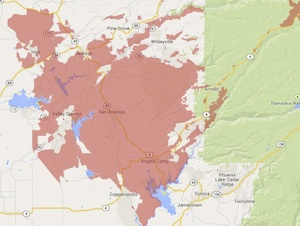
Click for more info and bigger maps.
Four wireless broadband projects intended to cover 18,000 homes in six Sierra Nevada counties are in the hunt for $8.1 million from the California Advanced Services Fund. Submitted yesterday by Cal.net, the plan is to use several kinds of unlicensed and semi-licensed spectrum – 5 GHz, an LTE-type technology in the 3.65 GHz band, a new but a not yet approved allocation in the 3.55 GHz range and television white space – to cover 1,440 square miles in Alpine, Amador, Calaveras, El Dorado, Mariposa and Tuolumne counties.
Primary backhaul will be via its own network, which includes licensed point-to-point wireless segments, back to the Cal.net network operations center in Shingle Springs, although the application also mentions that it’ll use fiber from the Central Valley Independent Network, a middle mile fiber system funded by both CASF and the 2009 federal stimulus program that runs through the Sierra foothills.
On the average, the four proposals are looking for a $450 subsidy per home in the area the projects are supposed to cover. No subscriber estimate was included in the public information released, nor was any indication of how many homes it would actually be able to reach – although Cal.net has considerable experience in the area, it won’t be possible to reach every home, given the terrain and distances involved. Particularly using unlicensed spectrum as the last mile link.
No information was released either, regarding proposed broadband speeds, pricing or service levels, although the plan is to offer VoIP-based phone service as well.
The total cost of the four projects is somewhere between $11.5 million and $13.4 million. That’s assuming that the grants requested are for 60% to 70% of the tab, per standard CASF rules, which provide 60% subsidies for underserved areas – where there’s some broadband availability but at speeds less than 6 Mbps down/1.5 Mbps up –and 70% where homes are completely unserved.
Assuming all currently pending projects are approved – probably not a completely valid assumption – there will be a bit less than $100 million left in the CASF kitty.
